Synthesis, Structure, and Dielectric Properties of (3-Nitroanilinium) (18-Crown) (PF6)
Abstract
:1. Introduction
2. Results and Discussion
2.1. IR Spectroscopic Analysis
2.2. Hermogravimetric (TG) and DSC Analyses
2.3. Crystal Structure Analysis
2.4. Potential Energy Calculation
2.5. Dielectric Properties
3. Materials and Methods
3.1. Materials and Measurements
3.2. Preparation of (3-Nitroanilinium)(18-Crown-6)(PF6) (1)
3.3. Single-Crystal X-ray Diffraction Measurements
3.4. Calculation of Rotational Potential Energy
4. Conclusions
Supplementary Materials
Author Contributions
Funding
Conflicts of Interest
References
- Wang, X.-L.; Zhou, L.; Ye, Q.; Geng, F.-J.; Ye, H.-Y.; Fu, D.-W.; Zhang, Y. A spiro-type ammonium based switchable dielectric material with two sequential reversible phase transitions above room temperature. RSC Adv. 2016, 6, 74117–74123. [Google Scholar] [CrossRef]
- Zhang, W.; Xiong, R.-G. Ferroelectric Metal–Organic Frameworks. Chem. Rev. 2012, 112, 1163–1195. [Google Scholar] [CrossRef] [PubMed]
- You, Y.-M.; Liao, W.; Zhao, D.; Ye, H.-Y.; Zhang, Y.; Zhou, Q.; Niu, X.; Wang, J.; Li, P.; Fu, D.-W.; et al. An organic-inorganic perovskite ferroelectric with large piezoelectric response. Science 2017, 357, 306–309. [Google Scholar] [CrossRef] [PubMed] [Green Version]
- Liao, W.-Q.; Tang, Y.-Y.; Li, P.-F.; You, Y.-M.; Xiong, R.-G. Competitive Halogen Bond in the Molecular Ferroelectric with Large Piezoelectric Response. J. Am. Chem. Soc. 2018, 140, 3975–3980. [Google Scholar] [CrossRef] [PubMed]
- Zhang, W.Y.; Tang, Y.Y.; Li, P.-F.; Shi, P.P.; Liao, W.Q.; Fu, D.W.; Ye, H.Y.; Zhang, Y.; Xiong, R.G. Precise Molecular Design of High-T c 3D Organic–Inorganic Perovskite Ferroelectric: [MeHdabco] RbI3 (MeHdabco = N-Methyl-1, 4-diazoniabicyclo [2.2.2] octane). J. Am. Chem. Soc. 2017, 139, 10897–10902. [Google Scholar] [CrossRef]
- Zhang, Z.-X.; Zhang, T.; Shi, P.-P.; Zhang, W.-Y.; Ye, Q.; Fu, D.-W. Anion-Regulated Molecular Rotor Crystal: The First Case of a Stator–Rotator Double Switch with Relaxation Behavior. J. Phys. Chem. Lett. 2019, 10, 4237–4244. [Google Scholar] [CrossRef] [PubMed]
- Liao, W.-Q.; Zhang, Y.; Hu, C.-L.; Mao, J.-G.; Ye, H.-Y.; Li, P.-F.; Huang, S.D.; Xiong, R.-G. A lead-halide perovskite molecular ferroelectric semiconductor. Nat. Commun. 2015, 6, 7338. [Google Scholar] [CrossRef] [Green Version]
- Wang, Z.-X.; Liao, W.-Q.; Ye, H.; Zhang, Y. Sequential structural transitions with distinct dielectric responses in a layered perovskite organic–inorganic hybrid material: [C4H9N]2[PbBr4]. Dalton Trans. 2015, 44, 20406–20412. [Google Scholar] [CrossRef]
- Zhang, W.-Y.; Ye, Q.; Fu, D.-W.; Xiong, R.-G. Optoelectronic Duple Bistable Switches: A Bulk Molecular Single Crystal and Unidirectional Ultraflexible Thin Film Based on Imidazolium Fluorochromate. Adv. Funct. Mater. 2016, 27, 27–1603945. [Google Scholar] [CrossRef]
- Zhang, Z.-X.; Zhang, T.; Shi, P.-P.; Zhang, W.-Y.; Ye, Q.; Fu, D.-W. Exploring high-performance integration in a plastic crystal/film with switching and semiconducting behavior. Inorg. Chem. Front. 2020, 7, 1239–1249. [Google Scholar] [CrossRef]
- Pan, Q.; Liu, Z.-B.; Tang, Y.-Y.; Li, P.; Ma, R.-W.; Wei, R.-Y.; Zhang, Y.; You, Y.-M.; Ye, H.; Xiong, R.-G. A Three-Dimensional Molecular Perovskite Ferroelectric: (3-Ammoniopyrrolidinium)RbBr3. J. Am. Chem. Soc. 2017, 139, 3954–3957. [Google Scholar] [CrossRef]
- Tang, Y.-Z.; Yu, Y.-M.; Xiong, J.-B.; Tan, Y.-H.; Wen, H.-R. Unusual High-Temperature Reversible Phase-Transition Behavior, Structures, and Dielectric–Ferroelectric Properties of Two New Crown Ether Clathrates. J. Am. Chem. Soc. 2015, 137, 13345–13351. [Google Scholar] [CrossRef] [PubMed]
- Liu, S.; Li, J.; Sun, Z.; Ji, C.; Li, L.; Zhao, S.; Luo, J. Order-Disorder Phase Transition, Anisotropic and Switchable Dielectric Constants Induced by Freeze of the Wheel-Like Motion in a Hexafluorosilicate-Based Crystal. Chemistry 2016, 1, 5310–5315. [Google Scholar] [CrossRef]
- Zhang, H.-Y.; Song, X.-J.; Cheng, H.; Zeng, Y.-L.; Zhang, Y.; Li, P.-F.; Liao, W.-Q.; Xiong, R.-G. A Three-Dimensional Lead Halide Perovskite-Related Ferroelectric. J. Am. Chem. Soc. 2020, 142, 4604–4608. [Google Scholar] [CrossRef]
- Chen, L.-Z.; Cao, X.-X. Two novel phase transition materials based on 1-isopropyl-1,4-diazabicyclo [2.2.2]octan-1-ium. Chin. Chem. Lett. 2017, 28, 400–406. [Google Scholar] [CrossRef]
- Wang, Y.; Shi, C.; Han, X.-B. Organic–inorganic hybrid [H 2 mdap][BiCl 5 ] showing an above-room-temperature ferroelectric transition with combined order–disorder and displacive origins. Polyhedron 2017, 133, 132–136. [Google Scholar] [CrossRef]
- Han, X.-B.; Hu, P.; Shi, C.; Zhang, W. Structural phase transitions and dielectric transitions in a 1,4-diazabicyclo[2.2.2]octane (dabco) based organic crystal. J. Mol. Struct. 2017, 1127, 372–376. [Google Scholar] [CrossRef]
- Liu, Y.-L.; Ge, J.-Z.; Wang, Z.-X.; Xiong, R.-G. Metal–organic ferroelectric complexes: Enantiomer directional induction achieved above-room-temperature homochiral molecular ferroelectrics. Inorg. Chem. Front. 2020, 7, 128–133. [Google Scholar] [CrossRef]
- Xu, W.-J.; Chen, S.-L.; Hu, Z.-T.; Lin, R.-B.; Su, Y.-J.; Zhang, W.-X.; Chen, X.-M. The cation-dependent structural phase transition and dielectric response in a family of cyano-bridged perovskite-like coordination polymers. Dalton Trans. 2016, 45, 4224–4229. [Google Scholar] [CrossRef] [PubMed] [Green Version]
- Li, X.-N.; Li, P.; Wang, Z.-X.; Shi, P.-P.; Tang, Y.-Y.; Ye, H.-Y. The structural phase transition in a hybrid layered perovskite: [C7H16N]2[SnI4]. Polyhedron 2017, 129, 92–96. [Google Scholar] [CrossRef]
- Tang, Y.-Z.; Gu, Z.-F.; Xiong, J.-B.; Gao, J.-X.; Liu, Y.; Wang, B.; Tan, Y.-H.; Xu, Q. Unusual Sequential Reversible Phase Transitions Containing Switchable Dielectric Behaviors in Cyclopentyl Ammonium 18-Crown-6 Perchlorate. Chem. Mater. 2016, 28, 4476–4482. [Google Scholar] [CrossRef]
- Ye, H.-Y.; Li, S.-H.; Zhang, Y.; Zhou, L.; Deng, F.; Xiong, R.-G. Solid State Molecular Dynamic Investigation of An Inclusion Ferroelectric: [(2,6-Diisopropylanilinium)([18]crown-6)]BF4. J. Am. Chem. Soc. 2014, 136, 10033–10040. [Google Scholar] [CrossRef] [PubMed]
- Ye, H.-Y.; Ge, J.-Z.; Tang, Y.-Y.; Li, P.; Zhang, Y.; You, Y.-M.; Xiong, R.-G. Molecular Ferroelectric with Most Equivalent Polarization Directions Induced by the Plastic Phase Transition. J. Am. Chem. Soc. 2016, 138, 13175–13178. [Google Scholar] [CrossRef]
- Zhang, X.; Shao, X.-D.; Li, S.-C.; Cai, Y.; Yao, Y.; Xiong, R.-G.; Zhang, W. Dynamics of a caged imidazolium cation–toward understanding the order-disorder phase transition and the switchable dielectric constant. Chem. Commun. 2015, 51, 4568–4571. [Google Scholar] [CrossRef]
- Liu, Z.-Q.; Kubo, K.; Noro, S.-I.; Akutagawa, T.; Nakamura, T. Design of Crystalline Spaces for Molecular Rotations in Crystals. Cryst. Growth Des. 2013, 14, 537–543. [Google Scholar] [CrossRef]
- Liao, W.Q.; Ye, H.Y.; Fu, D.W.; Li, P.F.; Chen, L.Z.; Zhang, Y. Temperature-T;riggered Reversible Dielectric and Nonlinear Optical Switch Based on the One-Dimensional Organic—Inorganic Hybrid Phase Transition Compound [C6H11NH3] 2CdCl4. Inorg. Chem. 2014, 53, 11146–11151. [Google Scholar] [CrossRef]
- Ye, Q.; Shi, P.-P.; Chen, Z.-Q.; Akutagawa, T.; Noro, S.-I.; Nakamura, T. Flexible cis-Cyclohexane-1,4-diammonium Ion in Magnetic [Ni(dmit)2] Crystals. Eur. J. Inorg. Chem. 2012, 2012, 3732–3739. [Google Scholar] [CrossRef]
- Xu, G.; Chen, C.-H.; Zhang, L. Switchable dielectric behavior induced by a disorder–order structural phase transition in (C3H12N2)2(HSO4)2[Mn(H2O)4(SO4)2]. Polyhedron 2016, 117, 133–137. [Google Scholar] [CrossRef]
- Ye, Q.; Akutagawa, T.; Ye, H.Y.; Hang, T.; Ge, J.Z.; Xiong, R.G.; Noro, S.I.; Nakamura, T. Structural phase transition due to the flexible supramolecule of (4-cyanomethylanilinium)([18] crown-6) in [Ni (dmit) 2]− crystal. Cryst. Eng. Comm. 2011, 13, 6185–6191. [Google Scholar] [CrossRef]
- Liu, Y.; Chen, Y.; Xu, M.-J.; Zhu, C.-L.; Liu, Z.-Q. Synthesis, structure, and phase transition of a novel proton transfer in a supramolecular cation with 2-nitroanilinium based on 18-crown-6. J. Mol. Struct. 2017, 1148, 429–434. [Google Scholar] [CrossRef]
- Hoshino, N.; Yoshii, Y.; Aonuma, M.; Kubo, K.; Nakamura, T.; Akutagawa, T. Supramolecular Rotators of (Aniliniums)([18]crown-6) in Electrically Conducting [Ni(dmit)2] Crystals. Inorg. Chem. 2012, 51, 12968–12975. [Google Scholar] [CrossRef] [PubMed]
- Ohshima, Y.; Kubo, K.; Matsumoto, T.; Ye, H.-Y.; Noro, S.-I.; Akutagawa, T.; Nakamura, T. One-dimensional supramolecular columnar structure of trans-syn-trans-dicyclohexano[18]crown-6 and organic ammonium cations. Cryst. Eng. Comm. 2016, 18, 7959–7964. [Google Scholar] [CrossRef] [Green Version]
- Zhou, P.; Sun, Z.; Zhang, S.; Chen, T.; Ji, C.; Zhao, S.; Luo, J. Switchable Dielectric Phase Transition Induced by a Twisting Transformation in Diglycine Methanesulfonate. Chem. Asian J. 2014, 9, 996–1000. [Google Scholar] [CrossRef]
- Li, S.; Luo, J.; Sun, Z.; Zhang, S.; Li, L.; Shi, X.; Hong, M. Phase Transition Triggered by Ordering of Unique Pendulum-Like Motions in a Supramolecular Complex: Potassium Hydrogen Bis(dichloroacetate)-18-Crown-6. Cryst. Growth Des. 2013, 13, 2675–2679. [Google Scholar] [CrossRef]
- Liu, Z.; Liu, Y.; Chen, Y.; Zhao, W.-Q.; Fang, W.-N. Synthesis, characterization, and phase transition of an inorganic–organic hybrid compound, [(3-nitroanilinium + )(18-crown-6)][IO 4 − ](CH 3 OH). Chin. Chem. Lett. 2017, 28, 297–301. [Google Scholar] [CrossRef]
- Akutagawa, T.; Koshinaka, H.; Sato, D.; Takeda, S.; Noro, S.-I.; Takahashi, H.; Kumai, R.; Tokura, Y.; Nakamura, T. Ferroelectricity and polarity control in solid-state flip-flop supramolecular rotators. Nat. Mater. 2009, 8, 342–347. [Google Scholar] [CrossRef]
- Frisch, M.J.; Trucks, G.W.; Schlegel, H.B.; Scuseria, G.E.; Robb, M.A.; Cheeseman, J.R.; Montgomery, Jr.; Vreven, J.A.T.; Kudin, K.N.; Burant, J.C.J.; et al. People, Gaussian 03, Revision C.02; Gaussian Inc.: Wallingford, CT, USA, 2004. [Google Scholar]
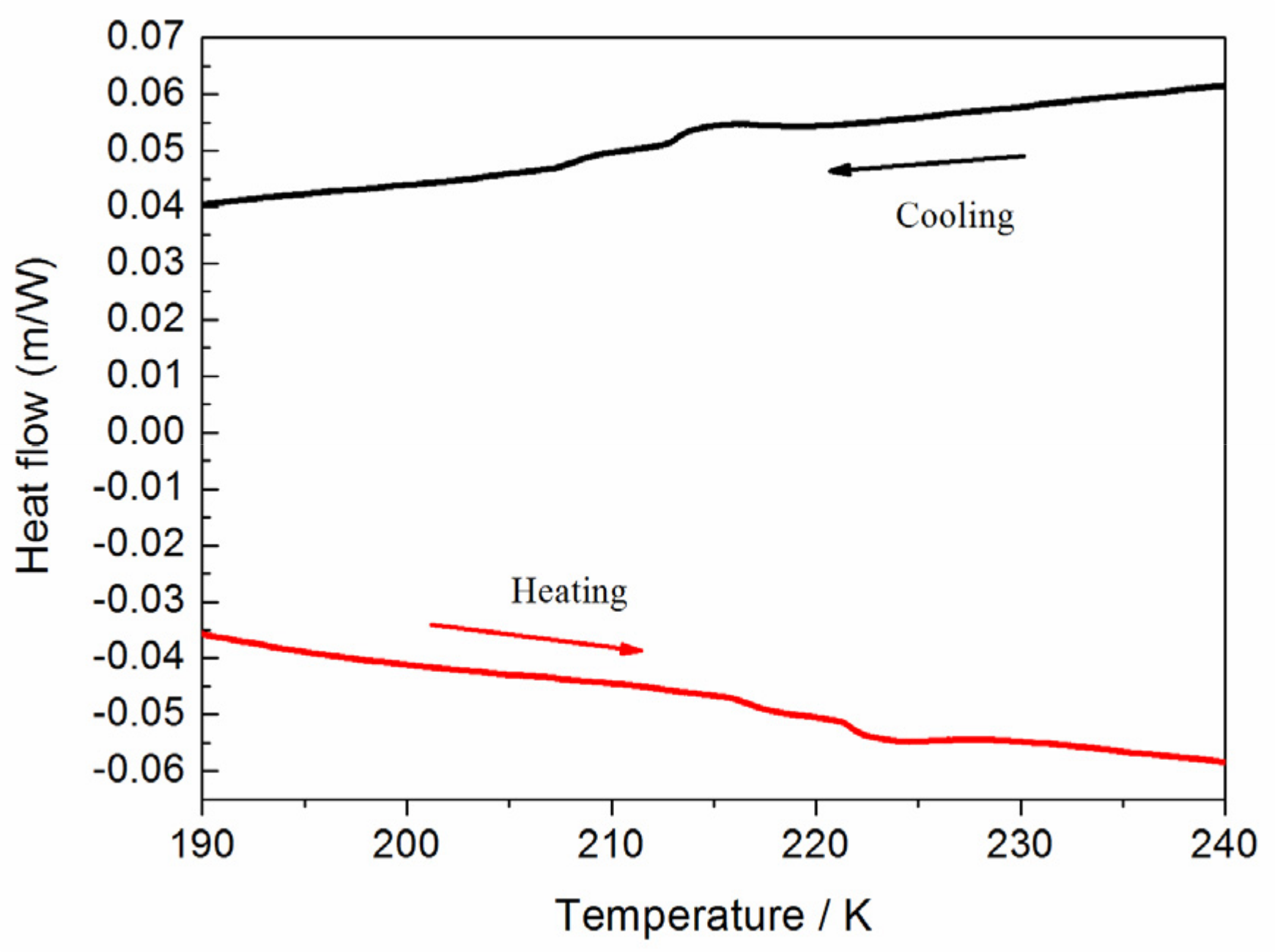
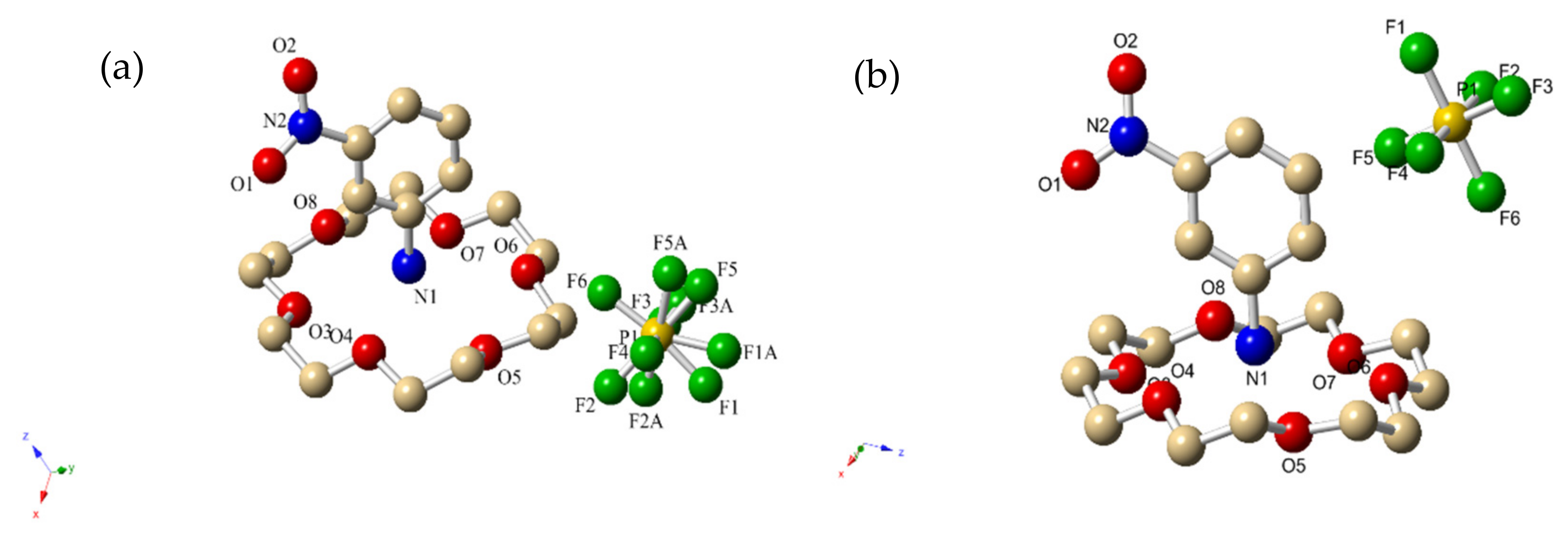
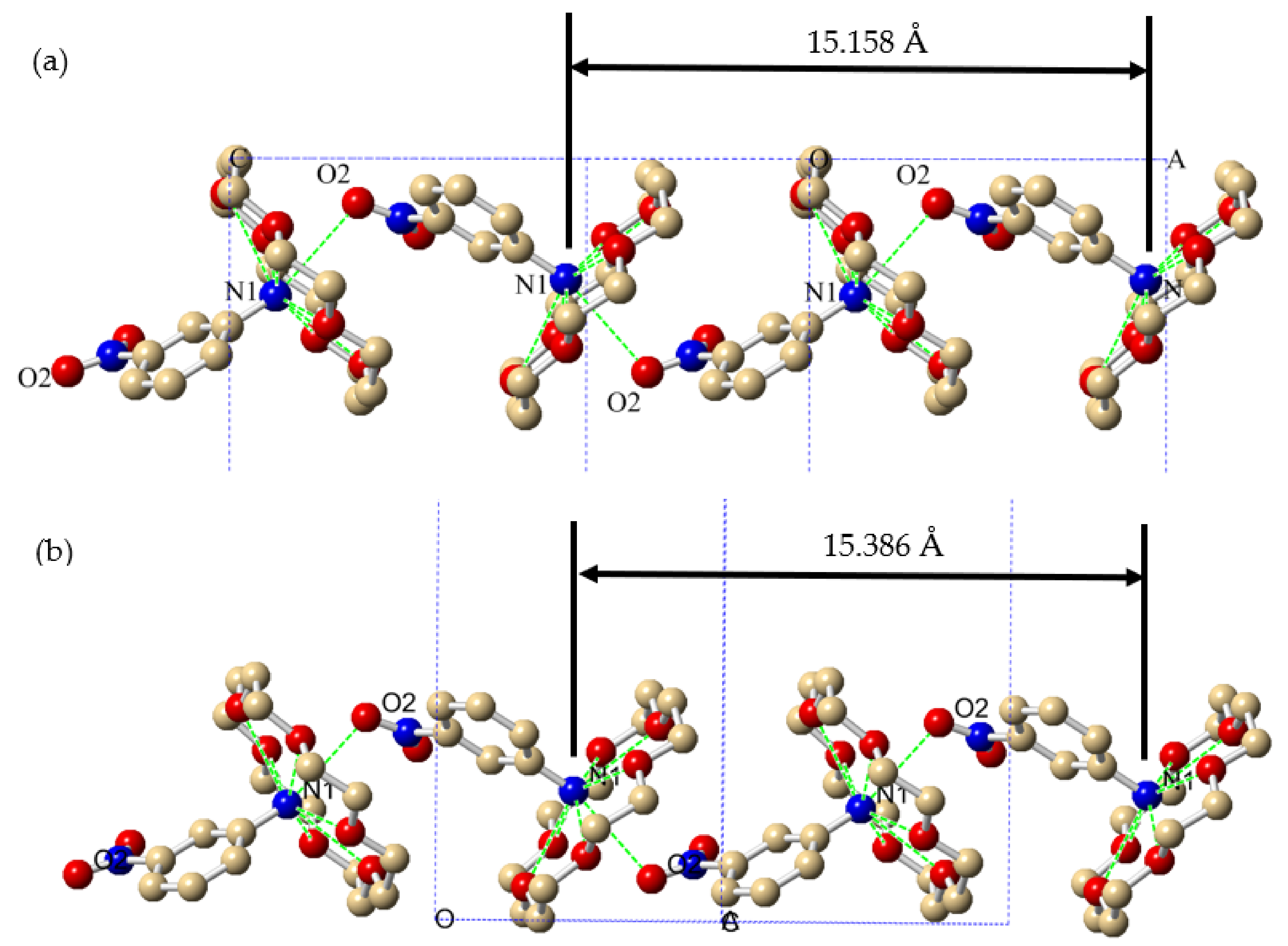

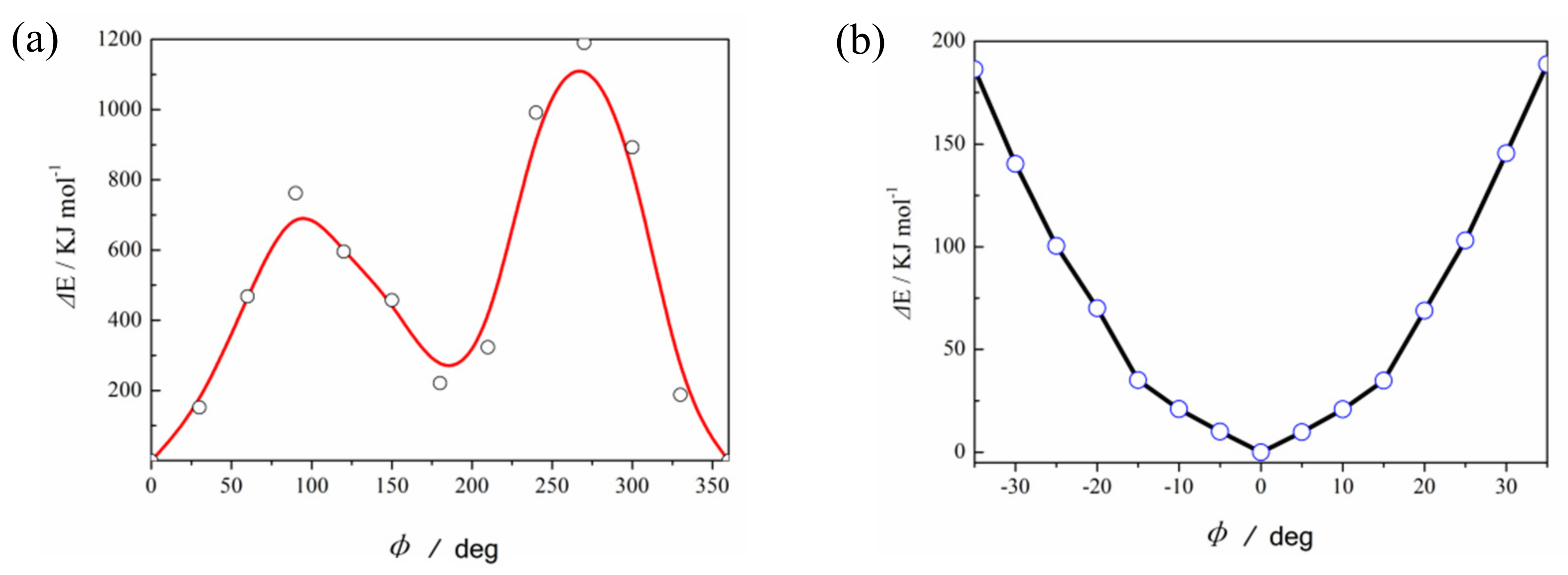
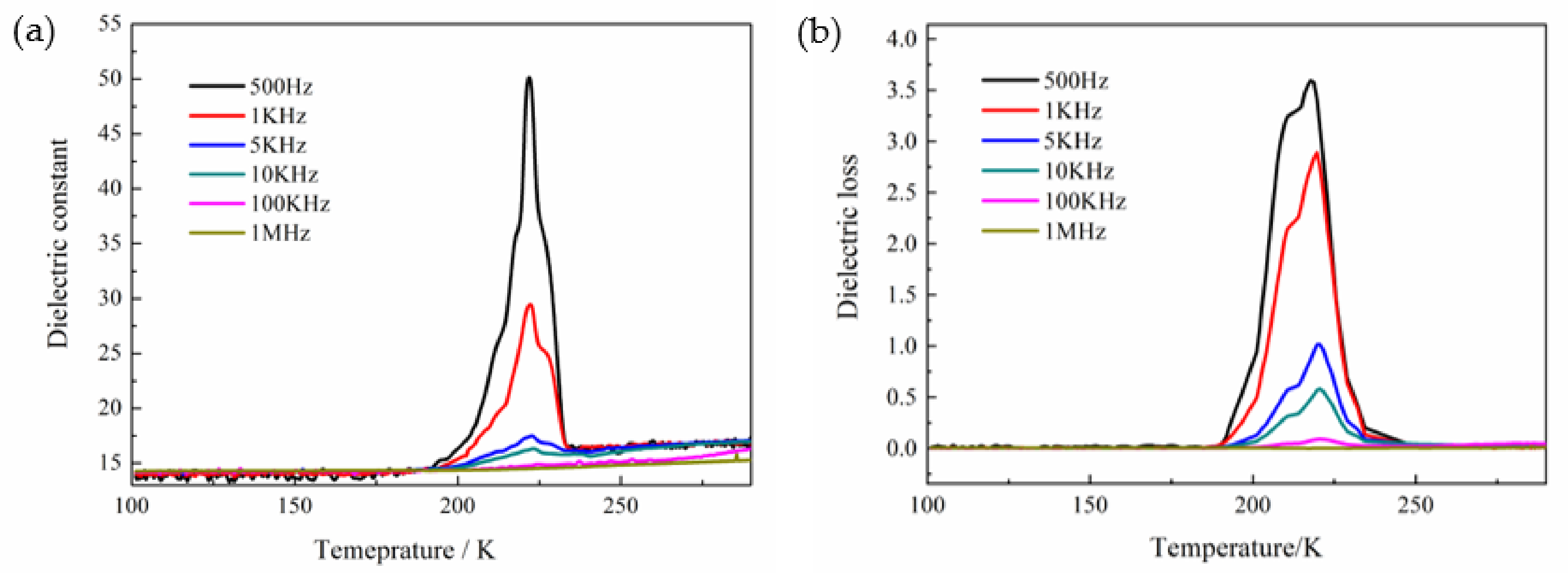

| Temperature | 128 K | 293 K |
|---|---|---|
| Chemical formula | C18H31F6N2O8P | C18H31F6N2O8P |
| Formula weight | 548.41 | 548.41 |
| Crystal size (mm3) | 0.43 × 0.31 × 0.16 | 0.313 × 0.248 × 0.116 |
| Crystal system | monoclinic | monoclinic |
| Space group | P21/n | P21/c |
| a (Å) | 13.7283(12) | 13.9331(12) |
| b (Å) | 12.9198(12) | 13.0960(12) |
| c (Å) | 15.3220(18) | 15.1576(13) |
| α (°) | 90.00 | 90.00 |
| β (°) | 116.314(2) | 116.884(2) |
| γ (°) | 90.00 | 90.00 |
| V(Å3) | 2436.0(4) | 2466.9(4) |
| Z | 4 | 4 |
| Dcalc (g·cm−1) | 1.490 | 1.474 |
| F(000) | 1136 | 1140 |
| μµ (mm−1) | 0.204 | 0.202 |
| Measured 2 range (º) | 0.960–25.00 | 0.999–25.242 |
| Rint | 0.0996 | 0.0783 |
| R (I > 2σ(I)) [a] | 0.1205 | 0.1044 |
| WR (all data) [b] | 0.2926 | 0.1951 |
| GOF | 1.004 | 1.064 |
Publisher’s Note: MDPI stays neutral with regard to jurisdictional claims in published maps and institutional affiliations. |
© 2020 by the authors. Licensee MDPI, Basel, Switzerland. This article is an open access article distributed under the terms and conditions of the Creative Commons Attribution (CC BY) license (http://creativecommons.org/licenses/by/4.0/).
Share and Cite
Wang, L.; Qin, L.-l.; Liu, Y.; Wang, P.; Xu, H.-t.; Liu, Z.-q. Synthesis, Structure, and Dielectric Properties of (3-Nitroanilinium) (18-Crown) (PF6). Crystals 2020, 10, 1028. https://doi.org/10.3390/cryst10111028
Wang L, Qin L-l, Liu Y, Wang P, Xu H-t, Liu Z-q. Synthesis, Structure, and Dielectric Properties of (3-Nitroanilinium) (18-Crown) (PF6). Crystals. 2020; 10(11):1028. https://doi.org/10.3390/cryst10111028
Chicago/Turabian StyleWang, Le, Liu-lei Qin, Yang Liu, Peng Wang, Hui-ting Xu, and Zun-qi Liu. 2020. "Synthesis, Structure, and Dielectric Properties of (3-Nitroanilinium) (18-Crown) (PF6)" Crystals 10, no. 11: 1028. https://doi.org/10.3390/cryst10111028
APA StyleWang, L., Qin, L.-l., Liu, Y., Wang, P., Xu, H.-t., & Liu, Z.-q. (2020). Synthesis, Structure, and Dielectric Properties of (3-Nitroanilinium) (18-Crown) (PF6). Crystals, 10(11), 1028. https://doi.org/10.3390/cryst10111028





